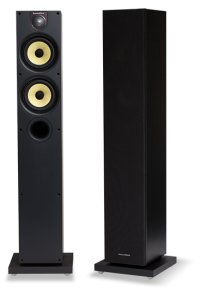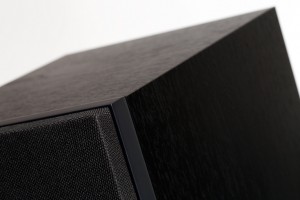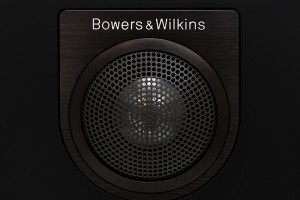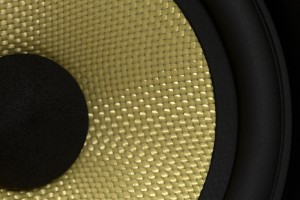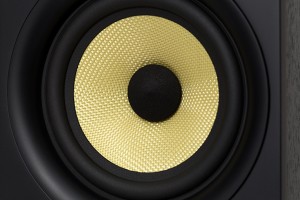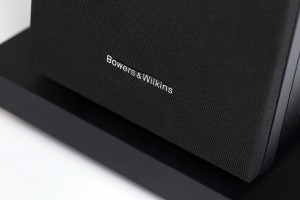Say “B&W” to non-audiophile consumers and they’ll probably think you’re mispronouncing BMW, which might be one of the reasons Bowers & Wilkins now prefers to go by its full name. But say “B&W” to any audiophile, and he or she will likely know precisely what you’re talking about: a British loudspeaker manufacturer founded in 1966 by John Bowers and Peter Hayward, and at first named B&W Electronics. Over time, as B&W grew and evolved, it became one of the best-known speaker makers in high-end audio, and in recent years has branched out into all-in-one music systems and headphones.
I’m pretty familiar with B&W — from about 1986 to 1998, it was the only brand of speaker I owned: pairs of Matrix 1s, Matrix 802 Series 2s, and Matrix 3 Series 2s, in that order. That’s why, with the recent debut of the 680 models, the latest iteration of their 600 series (the line began in 1995 with models DM601 through DM604), I was eager to get a pair in to see what B&W is up to today. They sent me a pair of 684 S2 floorstanders, which retail for $1150 USD per pair. Above the 684 is a larger floorstander, the 683 S2 ($1650/pair); below it are the stand-mounted 685 S2 ($700/pair) and 686 S2 ($550/pair).
Description
When I unboxed the 684 S2s, I was a bit surprised by their compactness. Each speaker measures 36.2”H x 6.3”W x 9.2”D, without the small wooden plinth (about 9.25”W x 1”H x 9.5”D) that bolts to its underside. Based on pictures I’d seen of the speaker prior to arrival, I expected something bigger. But after I got the pair set up and looked at them, I figured that B&W had gone small so that the speakers would fit more easily and discreetly into modern homes.
I wasn’t at all surprised by the high quality of the 684 S2’s MDF-based cabinet, which can only be had in Black Ash vinyl veneer. B&W has long been known for the exceptional finish work of all its products, as well as for excellent packaging and all the extras — the 684 S2 comes well protected inside its box, accompanied by rounded rubber footers and all-metal spikes, both of which screw into the plinth, for whatever kind of floor you might have, as well as an excellent manual for the 683 and 684 models. I also admired the well-thought-out grille, which is not only attractive but flexible and extremely durable. That last was important — during my listening tests I put them on and took them off repeatedly, sometimes roughly (a quick grab and pull!). Although the sound was better without the grilles, I replaced them from time to time to protect the drivers, as would most users.
The 684 S2’s plastic front baffle is designed to be sonically unobtrusive and visually attractive — it mounts over the driver frames and conceals unsightly bolts. Toward its top is what B&W calls a Decoupled Double Dome 1” aluminum tweeter, newly developed for and used in all of the 680 S2 models. According to B&W, a ring is added to the tweeter’s dome to push the natural resonance of aluminum well beyond the audioband; usually, that resonance is at a frequency within or undesirably close to the range of human hearing. The entire tweeter assembly is decoupled from the cabinet with a special mounting system designed to avoid the transfer of resonances to it, or vice versa. Below the tweeter are two 5” Kevlar-cone drivers with rubber surrounds. One of the benefits of Kevlar is that it can stop a bullet — something that’s obviously irrelevant when it comes to hi-fi. B&W uses it because, they say, it’s a choice material for “soaking up standing waves in a speaker cone.” Below the woofers is their version of a port, called a Flowport for the tiny dimples in its surface, which make it look like the surface of a golf ball and have the same function: to reduce air turbulence. Low on the rear panel are two pairs of binding posts, to facilitate biwiring or biamping. If, like me, you don’t want to go that route, the jumpers needed for single-wiring are already installed.
When I first saw the 684 S2’s three drivers, I assumed they were configured in a two-and-a-half- or three-way network, such that the bottommost driver wouldn’t hand off to the tweeter — partly because the two drivers are far away from each other, but particularly because B&W specifies a crossover frequency of 4kHz, which is quite high, and where the wavelengths of soundwaves are getting pretty short. But the 684 S2 is a two-way design: both woofers handle the same bandwidth of 45Hz-4kHz before the signal is crossed over to the tweeter. Suffice it to say, this piqued my interest — I wanted to hear how well these drivers’ outputs would blend.
According to B&W’s published specs, the end result of these three drivers working in unison is: a sensitivity of 87dB/2.83V/m; an overall frequency response of 45Hz-50kHz, -6dB; a “reference-axis” (presumably tweeter) frequency response of 72Hz-22kHz, +/-3dB, with the off-axis response remaining within 2dB across 60° horizontal and 10° vertical windows; harmonic distortion of less than 1%, 140Hz-22kHz (at 90dB output, measured at 1m); and a nominal impedance of 8 ohms, with a minimum impedance of 4 ohms. Whew — that’s a mouthful.
System: extreme to sane
I originally used the 684 S2s in my reference system, which includes tens of thousands of dollars’ worth of electronics: EMM Labs PRE2 preamp and DAC2X digital-to-analog converter, Simaudio Moon Evolution 870A or Hegel Music Systems H30 power amplifiers, etc. Those are extremely unlikely components to pair with a speaker costing only $1150/pair, and I did it mainly for convenience’s sake; the system was already set up, and it’s what I use for higher-priced speakers — and I wanted to at least hear how the 684 S2s would perform when given every opportunity to sound their best. But for the bulk of my listening I hooked up the 684 S2s to Hegel’s H80 integrated amplifier, which costs a sane $2000, puts out 80Wpc into 8 ohms (in short, enough), and includes a good DAC.
Sound
Whether the B&W 684 S2s were hooked up to my reference electronics or to the Hegel H80, my first impressions of their sound were mixed. I admired the cleanness and purity of the treble, but found it a bit too pronounced; the bass was full, robust, and quite deep, but also a little loose and indistinct; the midrange sounded smooth overall, but seemed a tad recessed in the upper mids, and in the lower mids was a touch chesty (a blurring, resonant sound) and hollow (think hands cupped around a mouth), particularly with certain performers. For example, Leonard Cohen’s deep, rich, close-miked voice in “Going Home,” from his Old Ideas (16-bit/44.1kHz FLAC, Columbia), exacerbated the chestiness, while Sade Adu’s close-miked voice in the title track of Sade’s Soldier of Love (16/44.1 FLAC, Sony Music Entertainment/RCA Records) highlighted the hollowness. These recordings each hit certain frequencies that these speakers just didn’t like.
Yet there were aspects about which I need make no caveat: The 684 S2s’ spacious sound helped unveil wide, deep soundstages; the imaging was very solid, and this, in concert with the spaciousness, led me to believe that each speaker’s three drivers in a two-way network were having no trouble blending to sound as if they were one. And they were able to play very loud without congestion. When I played “Contact,” the raucous closing track of Daft Punk’s Random Access Memories (24/88.2 FLAC, Édition Studio Masters), at SPLs far beyond what I’d expect a pair of small, entry-level floorstanders to be able to produce, they held together just fine — they didn’t break up or distort, as like-priced speakers often do. Likewise, Marc Anthony’s “Vivir Mi Vida,” from his 3.0 (16/44.1 FLAC, Sony Music Latin), sounded lively, clean, and surprisingly unrestrained, even when I cranked the volume way, way up.
Given the mixed results I’d initially heard, I did some subtle tweaking to attempt to keep the good and ditch the bad. First, since the 684 S2s’ bass was generous enough, I made sure not to place them any closer to the side and rear walls, as that would reinforce the low frequencies even more. But to reduce the treble level at the listening seat, I did reduce the toe-in; the tweeters were now aimed not directly at my ears, but out a little to each side. Next, I dispensed with the soft footers, screwed the spikes in tight, then gave a really hard push on the top of each speaker, so that the spikes pierced my carpeting and made contact with the floor, to give the 684 S2s the firmest footing. This usually reduces cabinet resonances, which results in the tightest bass and the cleanest midrange, all else being equal.
These small, simple tweaks yielded surprising benefits at no sonic cost. The bass tightened noticeably and, more surprising, now sounded a bit deeper — output down to almost 40Hz was apparent, which I consider very good for so small a speaker. The higher frequencies were still lively and clear, but no longer too forward, and never edged into “bright”; in fact, now that the 684 S2s were properly set up, I found their top-to-bottom balance quite pleasing overall, if still not perfectly neutral. The slight top-end attenuation also meant that the midrange sounded less recessed; in short, easier to hear. The increased physical stability made possible by the spikes also made the mids even smoother, which made most voices sound more natural and realistic, and pianos surprisingly clear. For example, Lang Lang’s performance of Satie’s “Gnossienne No.1,” from the soundtrack of the film The Painted Veil, was reproduced with dazzling clarity for a speaker at this price. The hollowness I’d heard in the Sade recording went away, but the spacious soundstaging of the original setup remained, as did the image solidity.
The only problem I couldn’t completely overcome was the chestiness in the lower midrange, which, once the 684 S2s were solidly spiked, was less obvious at quiet to normal listening levels, but still crept in when I played the music pretty loud. I’ve come to suspect that this is usually caused by an emphasis in the 200-300Hz range, though that’s just a guess. Whatever the cause, this was the 684 S2’s main weakness. You’ll need to listen to them with familiar music to see if it bothers you.
Other than that, I was impressed by what I heard, and found the B&W 684 S2 competitive with other models I know at or near its price. Although I liked the 684 S2’s overall tonal balance, it wasn’t as neutral a balance as those of, say, PSB’s Imagine T ($2200/pair) and KEF’s R500 ($2600/pair), which are similarly sized but more expensive floorstanders (I reviewed the KEFs, and have listened to the PSBs on many occasions), while still sounding very natural and quite involving. I also admired the fullness and depth of the 684 S2’s bass, which was certainly quite a bit more full and, ultimately, more satisfying than the bass of most speakers near this price that I’ve heard. Anyway, those speakers have tended to be small, stand-mounted minimonitors, so it’s no surprise that their bass is limited. Cambridge Audio’s Aero 2 ($550/pair), KEF’s LS50 ($1500/pair), and Monitor Audio’s GX50 ($1700/pair) are all quite accomplished-sounding small speakers for their prices, but none of them puts out much bass below 60Hz. And once I had the B&Ws positioned well, I admired their highs, which remained superclean even when I cranked the volume up high. In that regard, I would put the 684 S2’s sound quality up with that of the KEF LS50 and R500, the Monitor GX50, and the PSB Imagine T. B&W’s 680-series tweeter is that sweet.
Conclusions
With the 684 S2, Bowers & Wilkins has, true to form, shown that they still know how to produce products with excellent build quality, superb styling, and topnotch packaging. Absolutely no complaints there; in fact, I wish all companies could present their products as well as B&W does. However, the 684 S2s sounded a bit different from what I expected, and it took a bit of tweaking to get that sound to my liking. That done, I was rewarded with a spacious soundstage with very precise imaging; full, deep bass that belied the speaker’s modest driver complement and small cabinet size; a smooth midband; and crystal-clear highs that compared well with those of speakers costing quite a bit more. There was a downside — a chestiness in the lower midrange that was aggravated by certain tracks I used, particularly when played at high volumes. I was able to ameliorate this with tweaking, but couldn’t get rid of it entirely.
All told, B&W offers high value with the 684 S2 — the reason shoppers have long gravitated toward the company’s various 600 series. But I recommend that prospective buyers first listen to this new model with familiar music, to determine if it’s the right speaker for them.
Read more at: http://www.soundstagehifi.com/index.php/equipment-reviews/758-bowers-wilkins-684-s2-loudspeakers
Where to buy B&W: http://abtec.co.nz/product-search.php?keyword=Bowers+%26+Wilkins+684&category=&brand=&search=


